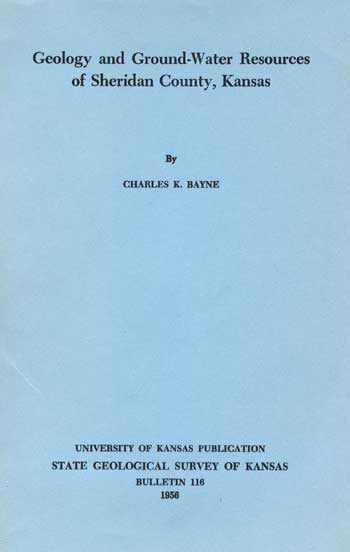Geology and Ground-water Resources of Sheridan County, Kansas
By Charles K. Bayne

Originally published in 1956 as Kansas Geological Survey Bulletin 116. This is, in general, the original text as published. The information has not been updated.
You may also wish to visit our web site on the Sheridan County geologic map.
Abstract
This report describes the geography, geology, and ground-water resources of Sheridan County, Kansas. The county is in the High Plains section of the Great Plains physiographic province and has an area of about 893 square miles. The population of the county in 1950 was 4,607, about 66 percent of which is on farms. The climate of the county is dry, subhumid to semiarid, the normal annual rainfall being 19.35 inches and the mean annual temperature being 53.6° F. Farming and livestock raising are the principal occupations in the county.
The rocks that crop out in Sheridan County are sedimentary and range in age from late Cretaceous to Recent. A map showing the surficial geology and cross sections showing the subsurface relations of the geologic formations are included in the report. Much of the county is underlain by the Ogallala formation of Tertiary age, which in the upland areas is mantled by loess of Pleistocene age. The Smoky Hill chalk member of the Niobrara formation (late Cretaceous) is the oldest rock cropping out in the county and is exposed only in the valleys of the major streams in the eastern part of the county. The Ogallala formation is the most important aquifer in the county although the alluvium and materials beneath the Pleistocene terraces yield water to wells.
The report contains (1) a map that shows the location of wells and the depth to water in wells for which records are given and that indicates that the depth to water ranges from less than 10 to about 160 feet; (2) a map that shows the shape and slope of the water table and that indicates that the water table slopes generally eastward at an average rate of 15 feet to the mile; (3) a map that shows the thickness of Pliocene and Pleistocene water-bearing materials, which range from a featheredge to 140 feet; and (4) a map showing the configuration of the pre-Tertiary bedrock surface. The ground-water reservoir is recharged chiefly by precipitation that falls locally and in areas to the west. Ground water is discharged primarily by transpiration and evaporation in the valleys where the water table is relatively shallow and to a lesser extent by subsurface movement into adjacent areas, by pumping, and by stream runoff. All public and most domestic and stock-water supplies in the county are obtained from wells.
Some irrigation has been practiced for several years in the county, but only one irrigation well was in operation during the summer of 1952; it obtained water from the Ogallala formation and was used to irrigate about 140 acres. Water from the alluvium and terrace materials has been used for irrigation in previous years. Additional large-capacity wells can be developed in the upland areas of the county although the yields will be dependent on the local thickness and permeability of the water-bearing materials.
Analyses of samples of water from 18 wells indicate that the water is suitable for most uses and that water from the Ogallala formation is slightly better in quality than water from the terrace deposits and from alluvium. The field data upon which the report is based are given in tables and include records of 160 wells, chemical analyses of 18 water samples, and logs of 34 test holes and 1 well.
Kansas Geological Survey, Geology
Placed on web Feb. 10, 2009; originally published May 1956.
Comments to webadmin@kgs.ku.edu
The URL for this page is http://www.kgs.ku.edu/General/Geology/Sheridan/index.html